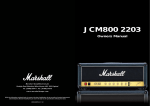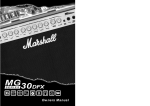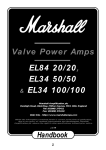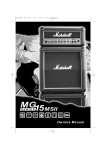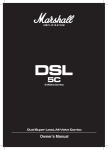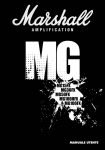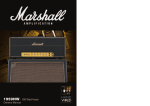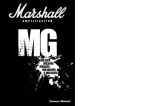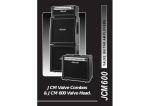Download Marshall JTM45 2245 audio amplifier
Transcript
1959SLP 1987X 2245 ‘JTM45’ 1962 ‘Bluesbreaker’ Marshall Amplification plc Denbigh Road, Bletchley, Milton Keynes, MK1 1DQ, England Tel : [01908] 375411 Fax : [01908] 376118 www.marshallamps.com BOOK-00066-00 / 1 / 02 BOOK-00066-00 / 2 / 02 Whilst the information contained herein is correct at the time of publication, due to our policy of constant improvement and development, Marshall Amplification plc reserve the right to alter specifications without prior notice. Owners Manual ! WARNING! - Important safety instructions A PLEASE read this instruction manual carefully before switching on. B ALWAYS use the supplied mains lead, if a replacement is required please contact your authorised Marshall Dealer. C NEVER attempt to bypass the fuses or fit ones of the incorrect value. D DO NOT attempt to remove the amplifier chassis, there are no user serviceable parts. E Refer all servicing to qualified service personnel including replacement of fuses and valves. Servicing is required when the apparatus has been damaged in any way, such as when the power supply cord or plug is damaged, liquid has been spilled or objects have fallen into the apparatus, the apparatus has been exposed to rain or moisture, does not operate normally or has been dropped. F NEVER use an amplifier in damp or wet conditions. No objects filled with liquids should be placed on the apparatus. G ALWAYS unplug this apparatus during lightning storms or if unused for long periods of time. H PROTECT the power cord from being walked on or pinched particularly at plugs, convenience receptacles and at the point where they exit from the apparatus. I DO NOT switch the amplifier on without a loudspeaker connected. J ENSURE that any extension cabinets used are of the correct impedance. From the Chairman I would like to personally thank you for selecting one of my vintage re-issue amplifiers. The Marshall reputation has been built upon many things, but our longevity comes mainly as a result of the continual relevance of the concepts behind the design and build of our amplifiers. Added to this are solid workmanship, reliability, stylish looks, and above all – great tone. The continual fascination and love that many guitarists show for our vintage amplification is a testament to just how relevant and important these models still are today. The amp you have just acquired was originally launched in the 1960s. A time when the face and sound of popular music was rapidly changing and players were constantly pushing back the musical boundaries. Each of these amps was there at the beginning of this music revolution and all played their part. From Pete Townshend, Eric Clapton and Jimi Hendrix, to Jeff Beck and Paul Kossoff, the list of great ‘tone’ players who pioneered the use of the natural distortion from these amps, reads like a who’s who of guitar players. Our re-issues of these models are as faithful as possible to the originals in terms of looks and tone. Hand-crafted in the UK these superb units feature finger-jointed cabinets of birch plywood, hand-welded chassis’s, hand-wired potentiometers and valve bases and the highest quality PCBs and componentry. I would like to wish you every success with your new amplifier and welcome you to the family of great players who use the classic Marshall tone. ➲ Note: This equipment has been tested and found to comply with the requirements of the EMC directive (Environments E1, E2 and E3 EN 55103-1/2) and the Low Voltage directive in the E.U. ➲ EUROPE ONLY - Note: The Peak Inrush current for the 1987X is 26 amps. The Peak Inrush current for the 1959SLP is 38 amps. The Peak Inrush current for the 1962 (Bluesbreaker) is 26 amps. The Peak Inrush current for the 2245 (JTM45) is 26 amps. ➲ CAUTION: Any changes or modifications not expressly approved by the party responsible for compliance may void the users authority to operate the equipment. ➲ Note: It is recommended that all audio cables, with the exception of the speaker lead, used to connect to the 1987X, 1959SLP, 1962 (Bluesbreaker) and the 2245 (JTM45) are of a high quality screened type. These should not exceed 10 metres in length. Always use a non-screened Marshall approved speaker lead when connecting an extension cabinet to these units. ➲ WARNING: Do not obstruct ventilation grilles and always ensure free movement of air around the amplifier! USA ONLY - DO NOT defeat the purpose of the polarised or grounding type plug. A polarised plug has two blades with one wider than the other. A grounding type plug has two blades and a third grounding prong. The wide blade or the third prong are provided for your safety. When the provided plug does not fit into your outlet, consult an electrician for replacement of the obsolete outlet. FOLLOW ALL INSTRUCTIONS AND HEED ALL WARNINGS KEEP THESE INSTRUCTIONS ! 1 2 ENGLISH ENGLISH WARNING: THIS APPARATUS MUST BE EARTHED! Introduction The Marshall re-issue range consists of the 100 Watt 1959SLP head, the 50 Watt 1987X head, the 2245 ‘JTM45’ head and 1962 ‘Bluesbreaker’ combo. All are faithful reproductions of the originals, which shaped the sound of the electric guitar as we know it. ENGLISH FX Loop Due to high demand, a sonically transparent effects loop has been added to the 1959SLP and 1987X models. This circuitry has been designed to not colour the guitar sound, so that your tone remains pure. The bypass switch gives you the option of completely removing this circuitry if desired. The effects loop level selector ensures compatibility with rack processors or floor pedals (stomp boxes). 3 4 ENGLISH The main characteristic that these amps share is their simplicity of operation and superb natural valve tone. Achieving the beautifully organic and vibrant overdrive which is their trademark, can only be done in one way – crank’em up! The result is pure, majestic tone uncluttered by unnecessary circuitry. With solos this produces a big, round, warm sustain, full of classic character. With chord work you get a bark and percussive attack with a natural sounding break up, which allows each note to ring out in a glorious musical crunch. 1959SLP & 1987X 1959SLP Rear Panel 10 1959SLP & 1987X Front Panel +4dBV -10dBV 12 ! EFFECTS LOOP BYPASS ACTIVE STANDBY PRESENCE 4 MK II 2 8 0 ON BASS 4 6 10 MIDDLE 4 6 2 8 0 2 10 TREBLE 4 6 8 0 10 HIGH TREBLE 4 6 2 8 0 10 ON 2 8 0 10 LOUDNESS 1 1 6 2 2 10 MAINS INPUT OUTPUT MAINS 110V ~ 60Hz 375 Watts atts 7 8 9 MAINS FUSE T3.15A 230V T6.3A 110V H.T. FUSE T1A OUTPUT: 100 WATTS RMS AND. 10 11 INPUTS 8 0 SELECTOR CONNECT SPEAKERS BEFORE USE SEND RETURN NORMAL 4 6 SELECTOR SPEAKERS LEVEL BYPASS MAINS WARNING!: RISK OF HAZARDOUS ENERGY AVIS!: ENERGIE ELECTRIQUE DANGEREUSE! 1 2 LOUDNESS 2 1 2 3 4 5 6 MODEL: 1987X 1 2 3 4 5 6 1. Power Switch 7 8 9 11 13 7. Treble Control On / Off Switch for mains power to the amplifier. +4dBV -10dBV LEVEL BYPASS RETURN Controls the high frequencies of the guitar tone, making your guitar sound brighter when increased. Please ensure the amplifier is switched off and unplugged from the mains electricity supply before being moved. 2. Standby Switch The Standby Switch is used in conjunction with the Power Switch (item 1) to ‘warm up’ the amplifier before use and to prolong the life of the output valves. (Note: The tone network is highly interactive and altering one control can change the shape of the sound in relation to the other tone controls. Experimentation is the best way to achieve your desired sounds.) 8. High Treble Loudness 1 Controls the overall output level of Channel 1. Note: This channel is voiced for a higher treble response than Channel 2. When powering up the amplifier always engage the Power Switch (item 1) first. This allows the application of the voltage required to heat the valves to their correct operating temperature. After about 2 minutes, when the valves are up to the correct temperature, the Standby Switch can be engaged. Upon doing this the H.T. (High Tension) which is the high voltage required by the output valves to pass signal (and hence produce sound) is applied. 9. Normal Loudness 2 Controls the overall output level of Channel 2. Note: Channel 2 is voiced for normal response. 10. Input Jack Connects the guitar to Channel 1. To prolong valve life, the Standby Switch alone should be used to turn the amplifier on and off during breaks in a performance. Also, upon full power down, always disengage the Standby Switch prior to the main Power Switch (item 1). 3. Indicator The Indicator will be lit when your amplifier is on and will not be lit when the amplifier is switched off. 4. Presence Control Adds higher frequencies to the guitar tone, creating crispness and bite. Turning this up will make the sound more cutting and ‘present’. Note: Though the first input of the first channel is the input that most guitarists use, don’t be afraid to experiment. Some guitar players prefer to mix the two channels together by connecting a short, screened patch lead between the second input of Channel 1 and the first input of Channel 2. If you then plug your guitar into the first input of Channel 1 (item 10), you can mix 1 2 the different tonal characters of INPUTS each channel for greater 1 2 flexibility. (See diagram). 11. Input Jack Connects the guitar to the lower sensitivity input on Channel 1. 5. Bass Control Controls the amount of low frequencies or bottom end in your tone. 12. Input Jack Connects the guitar to Channel 2. 6. Middle Control 13. Input Jack Dictates the middle register of the amplifier. Turning this up will make your guitar sound fatter. Conversely reducing the amount of middle in your tone will result in a sharper and thinner guitar sound for a more ‘scooped’ tone. Connects the guitar to the lower sensitivity input on Channel 2. EFFECTS LOOP BYPASS ACTIVE SEND ! WARNING!: RISK OF HAZARDOUS ENERGY AVIS!: ENERGIE ELECTRIQUE DANGEREUSE! SELECTOR SELECTOR MAINS INPUT OUTPUT MAINS 110V ~ 60Hz 175 Watts atts 7 8 9 SPEAKERS 3 4 5 6 1. Level MADE IN ENGLAND BY MARSHALL AMPLIFICATION PLC, BLETCHLEY, MILTON KEYNES, ENGLAND. 10 11 If running into two 16 Ohm cabs, the amp should be set to 8 Ohms. If running into two 8 Ohm cabs, the amp should be set to 4 Ohms. Provides two different loop levels to suit the type of effects connected to the series effects loop. The higher level (+4dBV) suits rack processors and the lower level (-10dBV) suits floor pedals. Failure to comply with these points will result in damage to the amplifier. 2. Bypass Your amp should be completely powered down before the selector is turned. This switch completely bypasses the circuitry involved in the effects loop to maintain absolute tonal integrity. 8. Mains Selector Matches the amplifier mains transformer voltage to the incoming mains voltage. Ensure that the rotary Mains Selector is set to the correct mains voltage applicable to the country where used. If you do not know the mains input voltage contact your authorised Marshall dealer. 3/4. Effects Loop To increase the flexibility of your amplifier further you may choose to add external effects. The Effects Loop allows direct connection of either floor pedals or rack processors, with the level control (item 1) providing the correct operating level. Your amp should be completely powered down before the selector is turned. Adjustment from 230/220V to 110V or vice versa will require the mains fuse to be changed to the corresponding value as detailed on the rear panel. Usually effects involving distortion or Wah Wah would not go through the loop, but between the guitar and amp input. Time or modulation based effects such as Chorus, Delay and Reverb are best suited to the loop. 9. Mains Input The signal is sent out from the amplifier to the input of your effects processor/pedal from socket 4 (Effects Send) then from the output of the processor/pedal is returned into the amp via socket 3 (Effects Return). Your amp is provided with a detachable mains (power) lead which is connected here. The specific mains input voltage rating that your amplifier has been built for is shown on the back panel. Before connecting for the first time, please ensure that your amplifier is compatible with your electricity supply. If you have any doubt, please get advice from a qualified person. Your Marshall dealer will help in this respect. 5/6. Loudspeaker Outputs These are for connection to an external load, i.e. speaker cabinet(s). (See item 7). Please refer to Important Safety Instructions, page 2. 10. Mains Fuse 7. Output Selector The correct value of mains fuse is specified on the rear panel of the amplifier. Please refer to Important Safety Instructions, page 2. Matches the amplifier’s output to the load impedance. With all-valve amplifiers it is imperative that the amp is connected to a load whilst in operation and that the impedance selected on the amplifier matches the total impedance of the speaker cabinet(s) being used. For example, if the amp is running into a single 16 Ohm cab, the amp should accordingly be set to 16 Ohms. 5 H.T. FUSE T500mA CONNECT SPEAKERS BEFORE USE OUTPUT: 50 WATTS RMS 1 2 MAINS FUSE T2A 230V T4A 110V 11. H.T. Fuse The correct value of H.T. fuse is specified on the rear panel of the amplifier. Please refer to Important Safety Instructions, page 2. 6 ENGLISH ENGLISH 1987X Rear Panel 1962 (Bluesbreaker) 12 1962 Front Panel 14 1962 Rear Panel ! MAINS STANDBY SPEED JTM 6 0 10 2 ON 1 8 4 6 0 10 2 PRESENCE 8 4 6 0 10 2 BASS 8 MIDDLE 4 6 0 10 2 8 4 6 0 10 2 8 TREBLE VOLUME I VOLUME II 4 6 4 6 4 6 0 10 0 10 0 10 2 8 2 8 2 1 1 4 5 6 7 1. Power Switch 8 9 10 11 13 15 8. Middle Control On / Off Switch for mains power to the amplifier. Dictates the middle register of the amplifier. Turning this up will make your guitar sound fatter. Conversely reducing the amount of middle in your tone will result in a sharper and thinner guitar sound for a more ‘scooped’ tone. Please ensure the amplifier is switched off and unplugged from the mains electricity supply before being moved. 2. Standby Switch The Standby Switch is used in conjunction with the Power Switch (item 1) to ‘warm up’ the amplifier before use and to prolong the life of the output valves. 9. Treble Control Controls the high frequencies of the guitar tone, making your guitar sound brighter when increased. (Note: The tone network is highly interactive and altering one control can change the shape of the sound in relation to the other tone controls. Experimentation is the best way to achieve your desired sounds.) When powering up the amplifier always engage the Power Switch (item 1) first. This allows the application of the voltage required to heat the valves to their correct operating temperature. After about 2 minutes, when the valves are up to the correct temperature, the Standby Switch can be engaged. Upon doing this the H.T. (High Tension) which is the high voltage required by the output valves to pass signal (and hence produce sound) is applied. 10. Volume I Controls the overall output level of Channel 1. Note: This channel is voiced for a higher treble response than Channel 2. To prolong valve life, the Standby Switch alone should be used to turn the amplifier on and off during breaks in a performance. Also, upon full power down, always disengage the Standby Switch prior to the main Power Switch (item 1). 11. Volume II Controls the overall output level of Channel 2. Note: Channel 2 is voiced for normal response. 12. Input Jack Connects the guitar to Channel 1. 3. Indicator The Indicator will be lit when your amplifier is on and will not be lit when the amplifier is switched off. 4. Speed Control Controls the speed of oscillation when using the tremelo effect. 5. Intensity Control Controls the intensity of oscillation (i.e. the effect depth) when using the tremelo effect. Note: The tremelo effect will only work when playing through Channel 2 of the Bluesbreaker combo. 6. Presence Control Note: Though the first input of the first channel is the input that most guitarists use, don’t be afraid to experiment. Some guitar players prefer to mix the two channels together by connecting a short, screened patch lead between the second input of Channel 1 and the first input of Channel 2. If you then plug your guitar into the first input of Channel 1 (item 12), you 1 2 can mix the different tonal INPUTS characters of each channel for 1 2 greater flexibility. (See diagram). FOOTPEDAL 1 2 3 1. Footpedal Jack T500 mA 117V ~ 60Hz 175 Watts T1.6A 230V T3.15A 117V 4 5 6 7 The correct value of H.T. fuse is specified on the rear panel of the amplifier. Please refer to Important Safety Instructions, page 2. Note: The tremelo effect will only work when playing through Channel 2. 6. Mains Input Your amp is provided with a detachable mains (power) lead which is connected here. The specific mains input voltage rating that your amplifier has been built for is shown on the back panel. Before connecting for the first time, please ensure that your amplifier is compatible with your electricity supply. If you have any doubt, please get advice from a qualified person. Your Marshall dealer will help in this respect. 2/3. Loudspeaker Outputs These are for connection to either the internal speakers and/or an external load, i.e. speaker extension cabinet(s). (See item 4). 4. Output Selector Matches the amplifier’s output to the load impedance. With all-valve amplifiers it is imperative that the amplifier is connected to a load whilst in operation and that the impedance selected on the amplifier matches the total impedance of the internal speakers and/or extension speaker cabinets. 7. Mains Fuse The correct value of mains fuse is specified on the rear panel of the amplifier. Please refer to Important Safety Instructions, page 2. The two internal speakers are 16 Ohms each. These are wired in parallel giving an overall impedance of 8 Ohms, therefore the output selector should be set to 8 Ohms. If an additional 8 Ohm extension speaker cabinet is used in conjunction with the internal speakers the output selector should be set to 4 Ohms. Note: No additional extension speaker cabinet with an impedance lower than 8 Ohms should be used in conjunction with the internal speakers. Failure to comply with these points will result in damage to the amplifier. Your amp should be completely powered down before the selector is turned. 13. Input Jack 15. Input Jack Connects the guitar to the lower sensitivity input on Channel 2. 7 SELECTOR 5. H.T. Fuse For connection of the supplied footswitch to allow tremelo to be switched on and off. Connects the guitar to Channel 2. Controls the amount of low frequencies or bottom end in your tone. MAINS FUSE OUTPUT: 30 WATTS RMS 14. Input Jack 7. Bass Control MAINS INPUT CONNECT SPEAKERS BEFORE USE Connects the guitar to the lower sensitivity input on Channel 1. Adds higher frequencies to the guitar tone, creating crispness and bite. Turning this up will make the sound more cutting and ‘present’. H.T. FUSE 2 MANUFACTURED BY MARSHALL AMPLIFICATION PLC BLETCHLEY, MILTON KEYNES, ENGLAND. 3 OUTPUT SPEAKERS INPUTS 8 ON 2 WARNING!: RISK OF HAZARDOUS ENERGY AVIS!: ENERGIE ELECTRIQUE DANGEREUSE! 2 8 ENGLISH ENGLISH INTENSITY 4 2245 (JTM45) 10 2245 (JTM45) Front Panel 12 2245 (JTM45) Rear Panel MODEL: JTM45 MAINS STANDBY PRESENCE MK II 6 0 10 2 ON 1 BASS 8 MIDDLE 4 6 0 10 2 8 4 6 0 10 2 TREBLE 8 4 6 0 10 2 8 ON 2 HIGH TREBLE 4 6 0 10 2 8 LOUDNESS 1 3 4 5 6 1. Power Switch 7 8 6 0 10 2 1 JTM 45 INPUTS 8 1 The Standby Switch is used in conjunction with the Power Switch (item 1) to ‘warm up’ the amplifier before use and to prolong the life of the output valves. 11 Controls the overall output level of Channel 1. Note: This channel is voiced for a higher treble response than Channel 2. 9. Normal Loudness 2 Controls the overall output level of Channel 2. Note: Channel 2 is voiced for normal response. 10. Input Jack Connects the guitar to Channel 1. Note: Though the first input of the first channel is the input that most guitarists use, don’t be afraid to experiment. Some guitar players prefer to mix the two channels together by connecting a short, screened patch lead between the second input of Channel 1 and the first input of Channel 2. If you then plug your guitar into the first input of Channel 1 (item 10), 1 2 you can mix the different tonal INPUTS characters of each channel for 1 2 greater flexibility. (See diagram). To prolong valve life, the Standby Switch alone should be used to turn the amplifier on and off during breaks in a performance. Also, upon full power down always disengage the Standby Switch prior to the main Power Switch (item 1). 3. Indicator The Indicator will be lit when your amplifier is on and will not be lit when the amplifier is switched off. 4. Presence Control Adds higher frequencies to the guitar tone, creating crispness and bite. Turning this up will make the sound more cutting and ‘present’. 1 2 1/2. Loudspeaker Outputs Please refer to Important Safety Instructions, page 2. T1.6A 230V T3.15A 117V 3 4 5 6 Your amp is provided with a detachable mains (power) lead which is connected here. The specific mains input voltage rating that your amplifier has been built for is shown on the back panel. Before connecting for the first time, please ensure that your amplifier is compatible with your electricity supply. If you have any doubt, please get advice from a qualified person. Your Marshall dealer will help in this respect. Matches the amplifier’s output to the load impedance. With all-valve amplifiers it is imperative that the amp is connected to a load whilst in operation and that the impedance selected on the amp matches the total impedance of the speaker cabinet(s) being used. For example, if the amp is running into a single 16 Ohm cab, the amp should accordingly be set to 16 Ohms. If running into two 16 Ohm cabs, the amp should be set to 8 Ohms. If running into two 8 Ohm cabs, the amp should be set to 4 Ohms. 6. Mains Fuse Failure to comply with these points will result in damage to the amplifier. Your amp should be completely powered down before the selector is turned. 13. Input Jack Connects the guitar to the lower sensitivity input on Channel 2. 9 117V ~ 60Hz 175 Watts 5. Mains Input 3. Output Selector Connects the guitar to Channel 2. Dictates the middle register of the amplifier. Turning this up will make your guitar sound fatter. Conversely reducing the amount of middle in your tone will result in a sharper and thinner guitar sound for a more ‘scooped’ tone. T500 mA The correct value of H.T. fuse is specified on the rear panel of the amplifier. Please refer to Important Safety Instructions, page 2. 12. Input Jack 6. Middle Control SELECTOR 4. H.T. Fuse These are for connection to an external load, i.e. speaker cabinet(s). (See item 3). Connects the guitar to the lower sensitivity input on Channel 1. Controls the amount of low frequencies or bottom end in your tone. MAINS FUSE CONNECT SPEAKERS BEFORE USE 11. Input Jack 5. Bass Control MAINS INPUT MANUFACTURED BY MARSHALL AMPLIFICATION PLC BLETCHLEY, MILTON KEYNES, ENGLAND. 13 8. High Treble Loudness 1 When powering up the amplifier always engage the Power Switch (item 1) first. This allows the application of the voltage required to heat the valves to their correct operating temperature. After about 2 minutes, when the valves are up to the correct temperature, the Standby Switch can be engaged. Upon doing this the H.T. (High Tension) which is the high voltage required by the output valves to pass signal (and hence produce sound) is applied. H.T. FUSE OUTPUT: 30 WATTS RMS (Note: The tone network is highly interactive and altering one control can change the shape of the sound in relation to the other tone controls. Experimentation is the best way to achieve your desired sounds.) 2. Standby Switch JTM 45 2 LOUDNESS 2 9 OUTPUT SPEAKERS Controls the high frequencies of the guitar tone, making your guitar sound brighter when increased. Please ensure the amplifier is switched off and unplugged from the mains electricity supply before being moved. WARNING!: RISK OF HAZARDOUS ENERGY AVIS!: ENERGIE ELECTRIQUE DANGEREUSE! 2 7. Treble Control On / Off Switch for mains power to the amplifier. ! NORMAL 4 10 The correct value of mains fuse is specified on the rear panel of the amplifier. Please refer to Important Safety Instructions, page 2. ENGLISH ENGLISH 4







